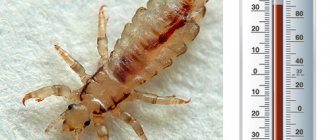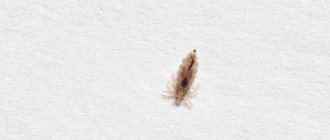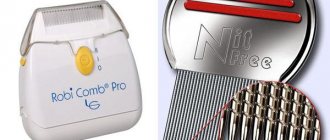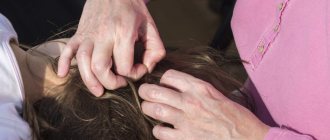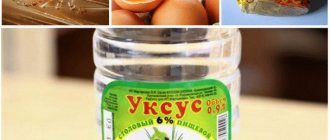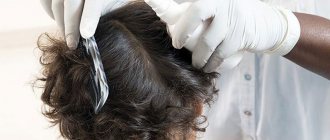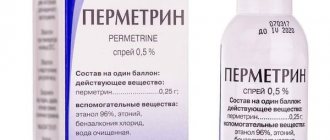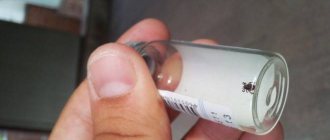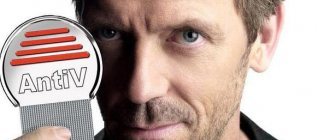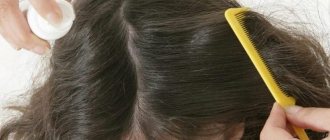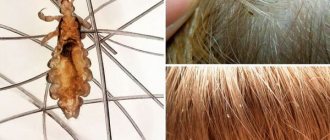There are many professional and gentle remedies for head lice, but traditional medicine methods that kill lice and their eggs are also in demand. For example, women are interested in whether lice live on dyed hair, because if hair dye kills lice and nits, then you can get rid of the problem and change your image.
Lice on colored hair.
Features of lice and nits
Lice are small parasites whose size does not exceed 4 mm. They cannot fly or jump; they move solely using their prehensile paws. The body of lice is covered with a dense chitinous shell on which the respiratory organs are located. They live on the human head in the hair and feed on blood. They die under the influence of chemical odors. Lice can live on the head for up to 1.5 months; without a host they die in 3 days.
Lice on a child's head.
Nits are lice eggs. No more than 1 mm long, have an oblong shape, white color, dense shell. It is denser than the shell of lice, so nits are more resistant to chemicals.
The nit does not move; the louse fixes it to the hair using a special substance. It hardens, so the nit cannot be combed out or washed out of the hair. After 7-10 days, an adult will emerge from the egg, and the cocoon will remain on the curls.
During the first week after hatching from the egg, small lice do not reproduce, but are parasitic. After 7 days, their reproductive system is fully formed, which allows individuals to lay new eggs.
Disadvantages of the method
In addition to its advantages, the use of coloring agents, like any other method, has its disadvantages. The following unpleasant moments arise during hair coloring:
- the possibility of an allergic reaction to the coloring agent;
- a complete change in color, which some women are not ready for. Especially those who have not previously used hair coloring;
- damage to the hair structure;
- the possibility of troubles with the scalp, for example, itching, dryness;
- increased hypersensitivity of the skin, which leads to an increase in the number of nits.
Before applying the coloring agent, you need to make sure that the person does not have an allergic reaction to the components. To do this, you need to conduct a test to determine the sensitivity of the skin on the back of your hand. If after 5 minutes, a burning sensation occurs, redness, and a rash appear, then to combat parasites you should choose another method, for example, shampoos for head lice, which can be purchased at any pharmacy.
Does hair dye kill lice and nits?
Pediculosis is treated with products for external use (shampoos, ointments, lotions), including those prepared independently according to traditional medicine recipes. One effective home remedy that will kill lice is hair dye.
Effect of paint on insects
Any hair dye consists of two components: a dye and an oxidizing agent. The first element does not in any way affect the viability of lice and nits, and the oxidizing agent can corrode the protective layer of the parasites’ shell, causing them to die. In addition, chemical vapors enter the respiratory tract of parasites and destroy their organs.
Hydrogen peroxide is used as an oxidizing agent.
Effect of hydrogen peroxide
Effect of hair dye on insects.
Peroxide, reacting with the dye, corrodes the chitinous layer of lice. Nits have a stronger shell, so the substance does not always kill them. After dyeing, use a fine comb to remove dead lice and nits.
Contraindications
It is prohibited to use hair dyeing to combat head lice in the following cases:
- children under 16 years of age. Since the coloring agent can cause burns to sensitive skin;
- during pregnancy. Since the oxidizing agent penetrates the placental barrier and harms the fetus;
- if there are scratches and wounds on the head, which often occur due to insect bites;
- when breastfeeding, since the toxic components of the paint corrode the damaged epithelium and penetrate into breast milk.
Criteria for choosing a coloring agent
When choosing a hair dye, it is important to pay attention to the oxidizing agent: it must contain ammonia or perhydrol. Ammonia is equally effective at killing both lice and nits. Peroxide is less harmful to eggs, but kills adults just as effectively as ammonia.
When choosing a paint, you should give preference to blonde shades: they contain a higher percentage of oxidizing agent, the reaction is more powerful and releases more vapors and heat.
Gentle ammonia-free paints, henna and basma are not suitable. Also, do not use paint that has expired or is of unclear composition. It is not recommended to go to a hairdresser; therapeutic coloring can only be done at home.
Can lice appear on colored hair?
When there is a suspicion of lice infection, almost every representative of the fair half of humanity asks the question of whether lice get in colored hair?
Despite the fact that some paints contain components that have a negative effect on the body of parasites , lice can feel quite comfortable if the dyeing procedure was carried out several days ago. Thus, the answer to the question of whether lice live on colored hair can only be positive.
Why don't lice live on painted ones?
Exceptions that exclude the possibility of lice include the regular use of aggressive dyes containing ammonia, perhydrol, and a number of others. On a head that is dyed at least once a week, lice may not appear.
However, dyeing so often is still not recommended, as curls and strands become brittle and dull. A strong, strong odor can repel lice. For example, seams do not sit on dyed hair directly during the dyeing procedure, as this may well cause their death.
Correct head painting
Painting your head as a way to get rid of lice.
How to dye your hair correctly to remove parasites:
- wash and dry your hair without using balms, masks, sprays or other care products;
- divide into strands and comb thoroughly;
- mix all parts of the paint in a glass or ceramic bowl (do not violate the proportions specified in the instructions);
- apply dye to the entire length of the hair, and then to the roots;
- tie a bun, cover your head with polyethylene and a warm cloth, leave for 40 minutes;
- wash off the paint;
- rinse your hair with a vinegar solution (2 tablespoons per 1 glass of water);
- comb with a fine comb;
- apply shampoo and lather it thoroughly;
- Rinse off all products and dry your hair.
For better distribution of paint, you can use a hairdressing brush and comb.
How to dye your hair correctly to make lice disappear
When carrying out a procedure aimed at using paint against lice, you must follow a number of certain rules that will help you quickly get rid of parasites.
These include:
- To begin with, it is recommended to test for skin sensitivity. To do this, apply a small amount of the selected product to your wrist or elbow, and evaluate the result after about a day. If there is no redness, you can start painting.
- Ammonia paints, the use of which kills lice, have a strong odor and a high level of resistance. To prevent staining of the skin, gloves are required.
- You need to apply the paint using a brush, carefully processing each strand in stages. The thicker the product is applied, the higher the likelihood of eliminating head lice.
The duration of the procedure may vary depending on the characteristics of the chosen product. As a rule, you need to keep the dye on your hair for thirty to forty minutes.
However, if you experience any unpleasant sensations, such as burning or itching, you should immediately remove the hair product.
After completing the dyeing procedure, you must wash your hair thoroughly, always using shampoo. Additionally, it is recommended to use hair balm, which will help facilitate the process of combing out lice. It is recommended to comb your hair directly after washing; you should only use a rare special comb for this, which will help remove dead lice and nits.
Advantages and disadvantages
With one staining, up to 80% of nits and lice will disappear. Why is this happening:
- Insects can hide in hard-to-reach or unpainted places.
- You can leave the dye on for a maximum of 40 minutes, otherwise there is a risk of damaging your hair. This may not be enough time to kill all the parasites.
What other disadvantages does paint have:
- the risk of choosing the wrong paint color;
- risk of developing allergies;
- cannot be used in advanced stages of pediculosis (when there are wounds);
- risk of skin burns.
Advantages of using hair dye:
- ease of use and accessibility;
- safer option than other chemical lice treatments;
- efficiency;
- speed of action;
- opportunity to change your image.
For a complete cure, at least 3 coloring sessions will be needed; this can have a detrimental effect on the condition of the hair and scalp. Therefore, it is recommended to use hair dye as an auxiliary measure, and not as the main means of therapy.
Advantages of the method
Hair dye in the fight against head lice has the following advantages compared to other methods:
- high degree of effectiveness, 80% of lice die after the first procedure;
- complete safety for the human body, subject to compliance with all staining rules and contraindications;
- cheapness of the method. Typically, paints containing ammonia and hydrogen peroxide are inexpensive;
- immediacy of the technique. More than half of the lice die immediately after the procedure;
- ease of use. To dye your hair you do not need any special knowledge or skills.
Attention! Hair dye can cope with head lice in a short period of time, without causing harm to human health.
General recommendations
Ways to get rid of lice.
What will help in the treatment of head lice, prevention and relapse prevention:
- Handling personal belongings. If a family member gets lice, then bedding, his clothes, towels and other things need to be treated.
The room must be vacuumed and washed with a disinfectant, things must be boiled or washed at 90°C and ironed with a hot iron. This will kill lice and nits.
- Disinfection of combs, elastic bands, hair clips. Personal items should be boiled or thrown away. To treat hats, you need to place them in a bag for a week - without blood and oxygen, the lice will die.
- Combing out dead individuals. They stick to the hair, so for 1 month after therapy you need to comb your hair 3 times a day with a fine-toothed comb.
- Prevention among those who have been in contact with the patient. Their things also need to be treated with boiling water and steam.
It is believed that lice only affect people from the lower class, but this is not true; you can become infected in any public place.
What to consider when painting
But if you really want to remove lice and nits using paint, you should use substances with perhydrol, ammonia and peroxide. This combination can negatively affect parasites, destroy their chitinous shell, paralyze their breathing and kill adult individuals. Nits do not die during dyeing, their shell is much thicker, so after the procedure it is necessary to comb the hair well with a comb, and after a few days repeat the combing procedure to remove newly hatched parasites.
- dilute the paint according to the instructions;
- cover your shoulders and body with a cape, and put on impervious gloves on your hands;
- use a brush to apply dye to strands of hair;
- put a plastic cap on your head and a towel on top to create a “greenhouse”;
- keep the composition on your hair for the required amount of time;
- wash your hair with shampoo;
- carefully comb each strand with a lice comb and destroy them (do this in the bathroom, do not allow the parasites to scatter around the apartment);
- apply hair conditioner;
- After three days, repeat the procedure of combing out parasites.
Even if you have selected a suitable paint with ammonia, perhydrol and peroxide, treatment does not guarantee complete destruction of lice. 80% of the nits will remain on the head, and after combing out their number will drop to 1-10%, but even a few hatched nits can recreate a whole army of parasites.
We strongly recommend using special pharmaceutical preparations to destroy lice without harming your hair. With one dyeing you will not 100% kill all the bloodsuckers, and frequent repeated dyeing will damage your hair, make it burnt and split.
In order to completely get rid of lice, you need to not only destroy living individuals, but also remove all larvae (nits).
It turns out that the disease is much more widespread than statistics say. Why are people silent about head lice?
Although parasites often appear in the hair of quite prosperous and even successful people, society has not yet overcome the shame of this disease due to the outdated opinion that insufficient hygiene contributes to infection.
In fact, lice prefer cleanliness, since the absence of dirt and oil on the skin makes it easier for them to access food - blood.
How can you get lice? Sometimes pediculosis is discovered in people who have not come into close contact with an infected person.
As a result, lice began to be credited with almost supernatural abilities. Many are sure that parasites can jump or even fly.
In fact, lice roam using two of their abilities: moving quite quickly (at a speed of 20 cm/min) and tenacity due to special hooks on their paws.
An insect can fall on you in transport, and you can become infected in public places: in a bathhouse or swimming pool.
What other types of pediculosis are there? There are three types of lice: head, pubic and body lice. Accordingly, insects infect scalp hair, clothing or pubic hair.
Each species lives and reproduces exclusively in the place corresponding to its name. However, one person can be infected with several types of lice at the same time.
If you or your child become infected, animals have absolutely nothing to do with it.
How to get rid of lice? For the generation of grandmothers, insects in the hair were even more stressful than for modern people, because in their time there were no effective pediculicidal drugs.
They tried to remove lice with means like herbal decoctions or vegetable and berry juices. When this did not help, stronger means were used, such as kerosene.
Paint against lice and nits
Hair dye is one of the readily available ways to combat head lice. In addition, a short treatment procedure does not pose a particular health hazard, provided that the recommendations of the manufacturer of the coloring composition are followed.
To achieve a full result, three and sometimes even four procedures are necessary. Moreover, re-treatment should be carried out no more than after 6-7 days. It is unlikely that such an active effect on the hair and scalp will be beneficial. Also, do not forget about the risk of allergies to the coloring composition.
Pediculosis causes itching, burning and irritation of the skin, it is dangerous because it can cause the development of other diseases, and it is easy to become infected.
Under what conditions do head lice appear?
- when swimming in a polluted body of water;
- when using other people's personal belongings (combs, hairpins, clothes);
- in public transport;
- in close contact with an infected person.
Ways to fight
Unfortunately, no one is immune from the appearance of pediculosis. You can catch it through contact with already infected people, in places where there is public bedding and underwear, in schools, kindergartens and even in hospitals. So what to do if there are lice on long hair? - Let's figure it out.
All existing methods of combating the disease can be divided into 2 groups:
- mechanical method - that is, direct removal of lice and nits from hair by combing or removal of the hair itself;
- chemical – exposure of parasites to substances harmful to them (and sometimes to us).
Using methods from both groups at the same time leads to success. If pediculosis appears in a child, then it makes sense to consult a specialist - a pediatrician or dermatologist before starting treatment.
You should also see a doctor if it recurs. Contacting a medical facility is only necessary to ensure that the medicine is selected correctly.
This will save you from wasting extra money and causing damage to your health.
How common is head lice?
In Russia, more than three hundred thousand cases of head lice are recorded every year. However, the number of products against lice and nits sold by pharmacies exceeds two million packages. It turns out that pediculosis is more widespread than is evident from the statistics.
This happens because people are ashamed of lice and do not always seek help from a doctor, trying to get rid of the disease on their own. And the difference in these indicators proves that not all products help remove lice and nits.
Children are more susceptible to infection because, unlike adults, they communicate freely with each other. But head lice can affect anyone.
Ancient peoples were much more afraid of lice than in the modern world with developed medicine. In those days, lice were treated exclusively with herbal infusions, vegetable and berry juices. When it was not possible to get rid of lice and nits, more atomic means such as kerosene entered the fight. However, this was an extreme measure, because the strong smell revealed a lousy person and his head was shaved. In the past, lice infestation was greatly feared, because they were carriers of dangerous and fatal diseases that developed into epidemics.
Methods of disposal
The female lives 8 weeks and lays up to 300 nit eggs, which are not susceptible to poisons due to the protective cocoon. Relapses occur 5-10 days after the elimination of lice, so we always repeat treatment procedures.
| Chemical method - common | Mechanical - harmless | Combined - the most effective | |
| The essence of the method | Treatment of the entire hairline with anti-pediculosis drugs. | Removing lice and larvae with a special comb. | Alternate use of first a chemical method against lice, then a mechanical one (against nits). |
| pros | Many drugs will get rid of adult lice in just one use. | Allows you to remove larvae and sedentary insects from wet hair | By combining the chemical destruction of adult lice and the mechanical removal of their nits, we will immediately exterminate the entire population. We can even use mild toxic drugs that will preserve our hair. |
| Minuses | The larvae still survive in a strong cocoon, so several such procedures are necessary. Skin irritation, dandruff or allergies may occur. | We carry out several such procedures on long hair. | The most expensive method: we purchase both a comb and a chemical. |
Lice (pediculosis) in children: treatment at home with folk remedies
Among the most popular folk remedies for head lice in children, the best ones include:
It is allowed to use folk remedies for lice in children in combination. Doctors recommend using them this way, because table vinegar makes it easier to comb out lice and nits, and hellebore water kills parasites.
Onion and garlic juice in combination with vegetable oil is extremely unpleasant for lice, makes them less active, and they practically stop laying eggs.
By supplementing all this with traditional hair treatment with an anti-pediculosis comb, you can completely get rid of pediculosis in 1-2 days without any health consequences.
Using table vinegar
Treatment with vinegar essence should be performed once a day, no more (so as not to damage the hair). To prepare the solution, take the most common table vinegar and dilute it in a 1 to 1 ratio with boiled, cooled water.
Next, all this is evenly applied to the hair using a brush or sponge, paying special attention to the hair roots and areas at the temples, behind the ears, and in the back of the head. This is where lice deposit nits the most.
After applying the vinegar solution, wrap the hair under a plastic bag or a simple bath cap, wait 20-30 minutes and wash off with shampoo and baby soap. After drying your hair, you should start combing out the parasites.
As a rule, 1-2 hair treatments are enough to completely eliminate the signs of head lice, as this is a very effective folk remedy for lice and nits for children.
But for the next 5-8 days, it is recommended to inspect the child’s hair daily for the presence of nits. If necessary, the processing is repeated.
Hellebore water
Hellebore water is an alcoholic tincture of the plant. For 100 milliliters of the finished composition, half is ethyl
This is precisely what the precautions for using a folk remedy for lice for children are connected with.
In small quantities, the drug does not have a negative effect on the child’s body, but in a dosage of over 20-30 milliliters with a single oral dose it can cause signs of poisoning.
It is worth considering that hellebore water is an external medicine!
Treatment against pediculosis with this product is carried out by analogy with table vinegar.
It’s just that it’s reused only after 7 days, not earlier.
A 25 percent solution is used to treat hair. If you use a pharmacy tincture, then it must be diluted in half with water.
Treated hair must be wrapped in polyethylene; after 8-15 minutes, the solution is washed off by washing twice with shampoo or baby soap.
After drying your hair, you need to comb it with a dry comb to remove dead parasites.
Onion and garlic juice
Onion and garlic juice are extremely nasty substances for parasites, so this folk remedy for head lice in children works great.
In addition, they increase local immunity and stimulate skin regeneration - this will be useful for chronic head lice, which is accompanied by dermatitis or the appearance of bleeding wounds.
To prepare the medicine you need:
- take 100 grams of onion and 20-30 grams of garlic;
- grind them on a fine grater or in a food processor or blender;
- the resulting pulp is wrapped in several layers of gauze, making a small bag. Place it on a narrow glass or shot glass so that the juice flows into the container on its own;
- Under no circumstances should you squeeze out the juice.
You will get approximately 40-50 milliliters of the mixture. Add 100 milliliters of vegetable oil to it (you can use olive oil - it gives less odor).
It is recommended to use this method after treatment with table vinegar or hellebore water.
Suitable means
There is a wide range of products that can be used to treat lice and nits at home. They are divided into industrially produced drugs, which are more effective, and traditional drugs, which are safer for the body. How to quickly and safely treat pediculosis? - read our article. What to choose, everyone decides for themselves, but if the task is to quickly and efficiently poison parasites, then pharmaceutical drugs will be the best option. They are divided according to their composition into the following categories:
- Insecticides. The basic principle of operation of these products is to block the respiratory openings of insects. The most effective include: Nyuda spray (96% dimethicone, 4% flavor); Para Plus (malathion, permethrin and piperonyl butoxide); Nittifor (permethrin 90%, cosmetic cream 10%).
Aromatic preparations. They contain aromatic oils that immobilize lice by affecting the central nervous system of insects. These include drugs such as: Pediculen Ultra (60% anise, allantoin, D - panthenol); LiceGuard is a product based on herbal ingredients.
Combined means. They consist of aromatic oils and a small percentage of insecticides. The most successful are: Paranit spray (4% dimethicone, 96% isopara mineral oil); Hygia shampoo (disodium ethylenediaminetetraacetate, bronopol, perfume composition).
ATTENTION! Most industrial products have an oily base and are difficult to wash off from hair. Before treating your hair, stock up on a good conditioner. If you use industrial products to treat lice in your hair at home, you must remember that each of them has its own contraindications
Pay special attention to safety issues if you have respiratory diseases (asthma, bronchitis), as well as various allergic reactions
If you use industrial products to treat lice in your hair at home, you must remember that each of them has its own contraindications. Pay special attention to safety issues if you have respiratory diseases (asthma, bronchitis), as well as various allergic reactions.
In addition to pharmaceutical drugs, there are a huge number of products that also help in the fight against head lice at home. There is no point in talking about gasoline and kerosene; these are completely unsafe liquids in their effects on the body. What folk remedies help against lice at home? - list for your attention:
- varnish "Prelest". You can choose any other varnish with a similar composition, but “Prelest” is cheaper. Treatment with varnish is done as follows: go outside or into a well-ventilated room, and completely spray the entire hair with this product. Treatment should begin from the roots. After this, the head is wrapped in a towel and kept on the head for about 40 minutes. Then the hair is washed;
- Ethyl alcohol is an effective medicine for lice and nits; it can be easily used at home. Can be purchased at a pharmacy. For long hair you will need at least two bottles. The liquid is rubbed into the roots of the hair, the head is wrapped in a towel and left for 30-40 minutes;
cologne. It works on the same principle as alcohol, only the smell from the hair is more pleasant than in the previous treatment option;
olive oil. It completely blocks the lice's access to air and helps to remove nits better. It is not possible to kill the entire population of insects the first time, so the treatment with olive oil is repeated 3-4 times;
hydrogen peroxide. Quite a radical way to get rid of lice, because the infected one changes their hair color. But, according to reviews, this method is the most effective of all folk remedies.
On our website you can also learn about such folk remedies for lice as: dichlorvos, essential oils, including tea tree oil, hellebore water, tar, laundry and dust soap. And representatives of the fair sex can get rid of lice with the help of hair dye - it, like hydrogen peroxide, contains elements that are poisonous to lice!
Nowadays, there are many remedies for the treatment of head lice. But, no matter which one you choose, you should remember that poisoning lice is half the battle. They leave their dormant scouts in the head of an infected person - nits, which in a couple of weeks will become insects, and the head will itch again. To prevent this from happening, carefully follow a certain procedure for removing lice and nits at home.
FAQ
Can there be lice on hair extensions?
You can use both real and synthetic hair extensions. Lice can attach to any type of hair, even hair extensions. Whether they survive or not depends on how long they are in your hair and whether you remove them. If you catch them in your hair extensions before they reach your scalp, you can avoid a lice infestation. However, if even one louse gets on your scalp, you need to take immediate action.
Are nits covered in hair coloring?
Parasites are not painted over because the components in the paint, such as ammonia or peroxide, are deadly to them. When paint gets on the shell of parasites, the insects' cover is corroded, which leads to their death.
